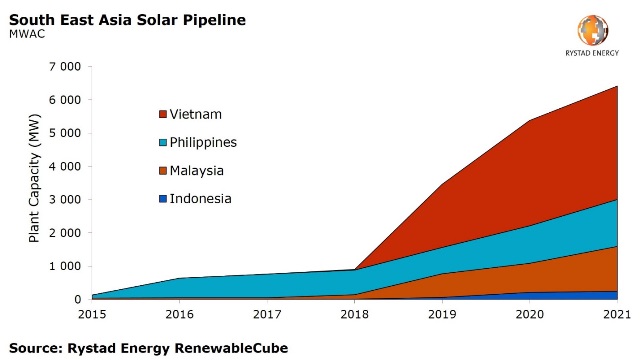The renewable energy sector is forecast to triple the installed capacity in 2019 in Southeast Asia, according to Rystad Energy’s annual outlook report.
“2019 is shaping up to be another red hot year for renewables in the Asia Pacific,” said Rystad Energy Senior Analyst David Dixon.
Vietnam has attracted 20 GW of large-scale solar developments in the pipeline, while wind sector will be adding another 20 GW. Installed power-generation capacity in Vietnam has reached around 42 GW. The government announced incentives for boosting the renewable energy sector in 2017.
“Developers are rushing to finish solar power plants in Vietnam in order to meet the feed-in-tariff (FiT) deadline of 30 June 2019, with 40 large-scale solar power plants currently under construction and expected to be connected to the grid by this date,” said Rystad Energy Analyst Minh Khoi Le.
Four of these large-scale projects – Dau Tieng Phases I & II, BIM phase II, Trung Nam and CMX Sunseap – are each bigger than the largest existing solar power plant in South East Asia (132 MWp).
The main concern in Vietnam is the risk of grid overload once these plants are completed. EVN, the country’s only utility company, will need to find more free space in the grid, or these plants will not be producing to their designed capacity.
Vietnam’s updated solar power policy will be the most important development in renewables energy market, following the conclusion of the current FiT this June.
Australia is in the process of commissioning more than 5 GW of solar and wind projects. The government may announce its national energy policy post-2020.
Malaysia will see its third large-scale solar auction (LSS 3) in 2019. The government stated last autumn that the targeted capacity was for 500 MW.
In the Philippines, the largest development likely to be commissioned in 2019 is the 150 MW Concepcion I in Tarlac.
In Indonesia, overall growth is expected to be muted due to policy uncertainty.

